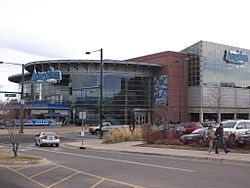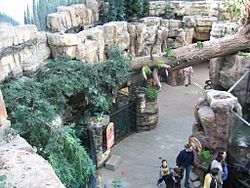Downtown Aquarium (Denver) facts for kids
 |
|

Exterior view from the parking lot
|
|
| Date opened | June 21, 1999 |
|---|---|
| Location | Denver, Colorado, U.S. |
| Land area | 17-acre (6.9 ha) |
| Coordinates | 39°45′6″N 105°0′51″W / 39.75167°N 105.01417°W |
| No. of animals | 5,000 |
| No. of species | 500 |
| Total volume of tanks | 1,000,000 US gallons (3,785,000 L) |
| Memberships | AZA |
The Downtown Aquarium in Denver, Colorado, is a super cool place to explore the underwater world! It used to be called Colorado's Ocean Journey. This amazing building is located near the South Platte River.
Inside, you'll find huge tanks filled with about 1 million gallons of water. These tanks are home to all sorts of fish and other animals. You can see both freshwater creatures and animals from the ocean. The Downtown Aquarium is owned by Landry's Restaurants, Inc. It is also approved by the Association of Zoos and Aquariums (AZA), which means it meets high standards for animal care.
History of the Downtown Aquarium
The aquarium first opened its doors on June 21, 1999. It was originally called "Colorado's Ocean Journey." Two people, Bill Fleming and Judy Petersen Fleming, started it as a nonprofit organization.
The idea behind "Ocean Journey" was to teach visitors about how rivers connect to the ocean. For example, the Colorado River flows all the way to the Sea of Cortez. The aquarium wanted to show how everything in nature is connected, from mountains and rivers to the sea.
After the events of 9/11 in 2001, fewer people visited the aquarium. This caused financial problems, and the aquarium had to file for bankruptcy in 2002.
In March 2003, a company called Landry's Restaurants, Inc. bought the aquarium. They kept it open for a while, then closed it briefly in 2005 for some big changes.
When it reopened on July 14, 2005, it had a new name: Downtown Aquarium. They added a full restaurant, a bar, and a large ballroom. A huge 150,000-gallon marine aquarium was also added right into the restaurant area!
Exploring the Exhibits
A main idea at the Downtown Aquarium is showing how freshwater places, like rivers, are connected to the ocean. The aquarium was first designed to follow the paths of two rivers.
One path was the Colorado River Journey. It showed animals from the Colorado River in North America. You could see endangered fish, different kinds of bass, and even North American river otters. This journey ended with a big tank showing the Sea of Cortez. This is where the real Colorado River flows into the ocean.
The other path was the Indonesia River Journey. It featured animals from the Kampar River in Indonesia. Here, you could see cool fish like Asian arowanas and rainbowfish. There were even Sumatran tigers! This journey ended with a large exhibit showing the southern Pacific Ocean.
After the big changes in 2005, the two journey paths are still there. However, the exhibits now show animals from different parts of the world. For example, some tanks now feature animals from African and South American freshwater places.
You can also find fun, hands-on exhibits. There's a horseshoe crab touch tank where you can gently feel these ancient creatures. There's also a stingray touch-and-feed tank, which is a favorite for many visitors!
The aquarium cares a lot about protecting animals. It has many threatened or endangered species. This includes 12 types of fish, six types of reptiles, two types of mammals, and two types of birds. The aquarium also helps with the AZA's Species Survival Plan for Sumatran tigers. This plan helps protect these amazing big cats.
Learning and Education
The Downtown Aquarium has a special volunteer program. It is run by a nonprofit group called the Deep Blue Sea Foundation. This group was created to make sure the aquarium continues to teach people about nature.
The aquarium also offers educational classes and workshops. These programs help visitors learn even more about aquatic life and conservation.
See also
 In Spanish: Acuario del Downtown para niños
In Spanish: Acuario del Downtown para niños



